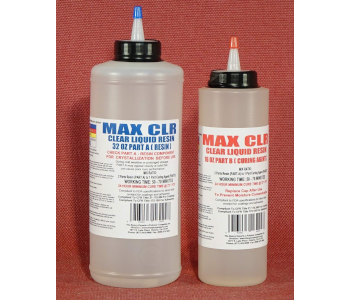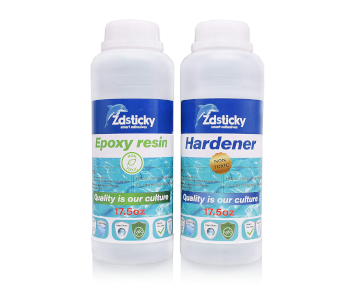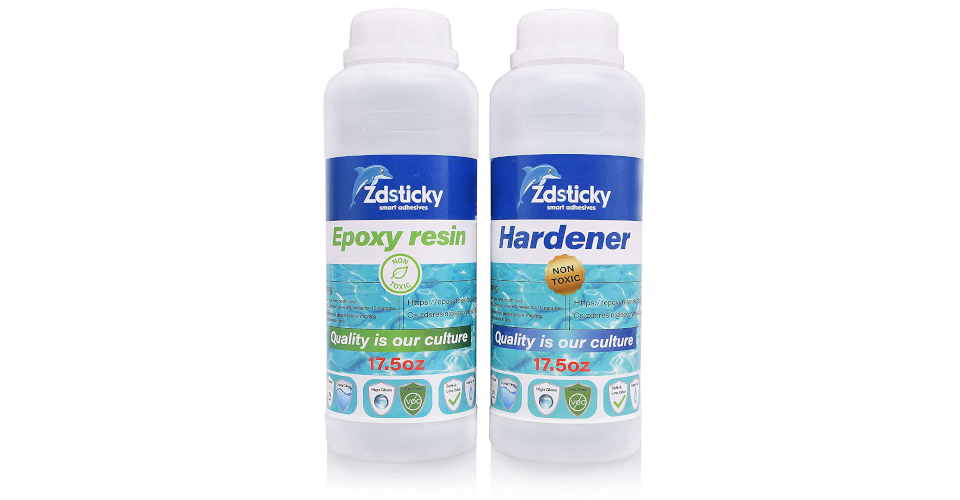What is Food Safe Epoxy and Where to Buy It?
Thanks to advances in materials science and biochemistry, we are now more aware of how the substances in our surroundings affect our bodies. These developments have affected not just the way that large-scale industries conduct their processes, but also the buying habits of the common consumer.
More recently, buyers have become more discerning of the chemical composition of the plastics that come in contact with their food. Epoxy is a pretty common resin substance used for adhesion and finishing of various plastic containers and surfaces. Is there such a thing as food safe epoxy?
What is epoxy?
Before we start discussing the food safety of epoxy, let’s start with a short discussion of what it is. The “epoxy” term is colloquial shorthand for the epoxide functional group. Polymers and prepolymers with epoxide groups are called polyepoxides.
The distinct characteristic of polyepoxides is that they can react with each other in the presence of a catalyst or a co-reactant. These co-reactants, commonly referred to as hardeners, can include amines, acids, alcohols, and phenols. When polyepoxides react with themselves, they form larger polymer chains that result in a material with improved hardness, thermal stability, and chemical resistance. This cross-linking reaction between the polyepoxides is called the curing step.
The exposure of most people with epoxies has been through adhesives that consist of two parts that need to be mixed together before they can be used. However, epoxy resins have also been used as insulators for electrical components, metal coatings, fiber-reinforced plastics, or as a means to mount samples for analysis in an electron microscope.
What compounds in epoxy should we be wary of?
In assessing the food safety of epoxy resins, we will need to consider the chemical composition of both the resin and the hardener.
The hardener component is easier to control because of the abundance of alternatives that can achieve the same result. In particular, any hardener with amines or aromatic amines runs the risk of contaminating food with toxic, mutagenic, or carcinogenic compounds. Thankfully, this isn’t something you need to worry so much about nowadays as the use of amine-containing hardeners has already become restricted. Epoxy manufacturers now prefer safer aliphatic or cycloaliphatic hardeners.
The other compounds to be wary of are a bit more problematic. Epoxy adhesives contain either bisphenol A (BPA) or bisphenol F (BPF). BPA, in particular, is a term that has been thrown around in the news a lot as a potential contaminant to drinking water, which can be leached off plastic water bottles. Unfortunately, BPA is very commonly used in epoxies because of its superior curing properties.
The question we should really be asking is: how bad is BPA for your health? Manufacturers of drinking bottles have made a big deal out of announcing their products are BPA-free, but is there really a cause for concern? Well, according to the FAA, BPA remains safe at very low levels. In fact, a huge majority of people regularly ingest some amount of BPA, as demonstrated by a study where BPA is detected in 93% of more than 2500 urine samples. The long-term health effects of BPA have also not been verified.
Tips on minimizing BPA contamination from epoxy
Despite some assurance from the FDA, we believe that the health concerns over BPA intake are valid and deserve to be addressed. The problem is that avoiding epoxy completely is almost impossible. Rather than attempt to look for epoxy alternatives, the best thing to do would be to make sure that the epoxy you’re using is FDA-approved for food contact. There are also best practices that you can follow to minimize BPA contamination.
1. Minimize the contact area of epoxy with food
BPA does leach to food or drink – historical results have proven that time and again. However, it’s possible to design parts in such a way that they contain BPA with the food material is minimized or outright eliminated. If you’re using epoxy as an adhesive, then it’s better to design the joints in such a way that they overlap completely, thus creating a barrier between the food and the epoxy. By minimizing the contact area between the epoxy and the food, you can minimize how much of the BPA gets leached out. Modern food and drink containers have become quite particular in adopting this design.
2. Avoid using epoxy for long-term storage
Temporary exposure of food and drinks to epoxy results in minimal leaching, so it’s best to avoid using epoxy-lined contained for long-term food storage. The logic behind this strategy is the same as the previous item – by reducing the time that the food is in contact with the epoxy, you can reduce how much of the BPA gets leached out of the epoxy. For this reason, the use of epoxy for food preparation equipment has been deemed to be safe. If you want to treat your kitchen countertops with some epoxy-based material, then go right ahead.
3. Mix the components of epoxy thoroughly and close to a 1:1 ratio
This is probably the most important tip when using any epoxy material – make sure as much of its raw materials as possible participate in the polymerization reaction. This way, all the hazardous components in both the resin and the hardener becomes part of the solidified epoxy resin, making them much less prone to leaching out.
Large-scale users of epoxy would even resort to accurately measuring the components and combining them in a static mixer. It’s also a bit more economical that way, as you don’t end up wasting any of the epoxy ingredients.
4. Finish the curing process
A good epoxy product should have a prescribed curing time somewhere in its packaging or instructions. Although an epoxy may start becoming hard in a few minutes, full curing can take more than a day. We suggest heeding these instructions to make sure that all of the components of the epoxy have been cured into the solid polymer phase.
Are there epoxy resins that are FDA-approved for food contact?
If you’re looking for food-safe epoxy products, then make sure that you get one that is FDA-approved. Even when you have confirmed that the approval is authentic, we also recommend using the epoxy exactly as instructed. This includes mixing the components in the prescribed ratio and following the curing time before you allow the epoxy to come into contact with food.
With those warnings aside, here are three examples of FDA-approved epoxy adhesives:
1. MAX CLEAR GRADE Epoxy Resin System

If you’ve done a cursory search for food-grade epoxy, then it would be impossible to miss this set of epoxy products from the MAX EPOXY brand. Sold in a range of sizes, this two-part clear epoxy resin is perfect for coating tables and countertops. It has a working time of up to 70 minutes and requires a 24-hour minimum curing time.
The applicability of this epoxy is excellent. Before curing, it has a very high viscosity, which makes it easier to fill in small gaps in the surface to which it is being applied. This also reduces the chances of bubbles forming in the epoxy. The downside of this characteristic is that it can be challenging to apply the epoxy on a surface that does not lay flat, as the uncured epoxy to flow.
According to the manufacturer, the MAX CLEAR GRADE epoxy is FDA-approved for brief-use direct food contact. It’s perfectly safe for use on wooden countertops that you will use for preparing food and has even been used to coat ceramic bowls and mugs with no ill effects. It’s a little more expensive than other epoxy resins, but this is a small price to pay to keep your food safe from contamination.
2. Atom Adhesives Medical-Grade Epoxy

This medical-grade epoxy from Atom Adhesives seems more geared towards industrial and commercial use than in homes. When cured, its mechanical properties are simply better- higher hardness and shear strength and better heat resistance. It’s also a better insulator, resists chemical degradation, and forms a very good moisture barrier.
As a testament to the safety of this epoxy to food contact, it has been heavily used in biomedical engineering, dental applications, and medical tools. Its high viscosity property makes it easy to apply the epoxy evenly and completely. You can use it for repairs as an adhesive or for coating and laminating of household fixtures and kitchen items.
The Atom Adhesives epoxy can be cured at room temperature for about 24 hours, or at 65 C for less than four hours. This is a nice option to have if you have to get a lot of work done in a short time.
This epoxy is a lot more expensive, even compared to the other food-grade epoxies out there. With better overall properties, we would consider it a high-performance product, which explains the price.
3. ZDSticky Epoxy Resin

The epoxy resin from ZDSticky comes in these very user-friendly plastic bottles that make them easier to dispense. Compared to the other epoxies in this list, this resin is a lot thicker, perhaps because it was designed more for making resin jewelry. While it would be great for that purpose, it becomes a lot harder to achieve a perfectly leveled surface. The thicker composition also makes it more difficult to remove the bubbles from the resin solution.
ZDSticky claims that the resin cures fully in 24 hours, but the experience of many users indicates that it takes quite a bit longer than that. It does look great when it dries -clear, smooth, and with a high-quality gloss. Getting it to that stage, however, can be quite a frustrating process.
There’s little doubt about the safety of the ZDSticky resin for food contact. It’s FDA-approved, contains no VOCs, and have passed strict documentation standards. It should work well enough for treating countertops and wooden surfaces. Its application process is a bit more complex because of its viscosity, but this is something that you can learn to work with. If you’re into casting or jewelry making, then this is the perfect resin for you.
Final thoughts
Being extremely selective of what we eat, what we put on our bodies, and what chemical we come in contact with is a somewhat recent trend that has been fueled by advance scientific knowledge. While some may argue that ignorance has been quite blissful for some time, perhaps it is still better to face the harsh reality. Some of the practices we have become used to are just not as healthy as beneficial to us as we would think.
When it comes to plastic that comes in contact with our food, we now know that BPA, a known mutagen and carcinogen, can be leached out to what we consume under the right conditions. This also applies to epoxy resin treatment – something is very common in a lot of households.






The FDA website says that they do not approve any adhesives or coatings and the best Epoxy resin can get is a “rating” of Compliant. Do these fall outside of that coatings and adhesive’s category for some reason or are you just using the the words compliant and approved the same?